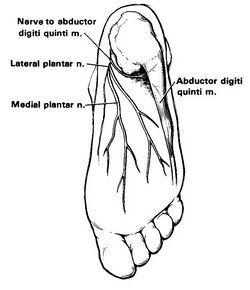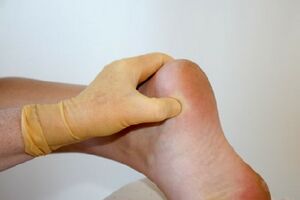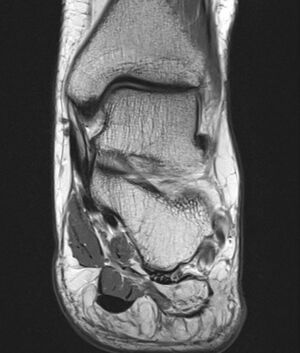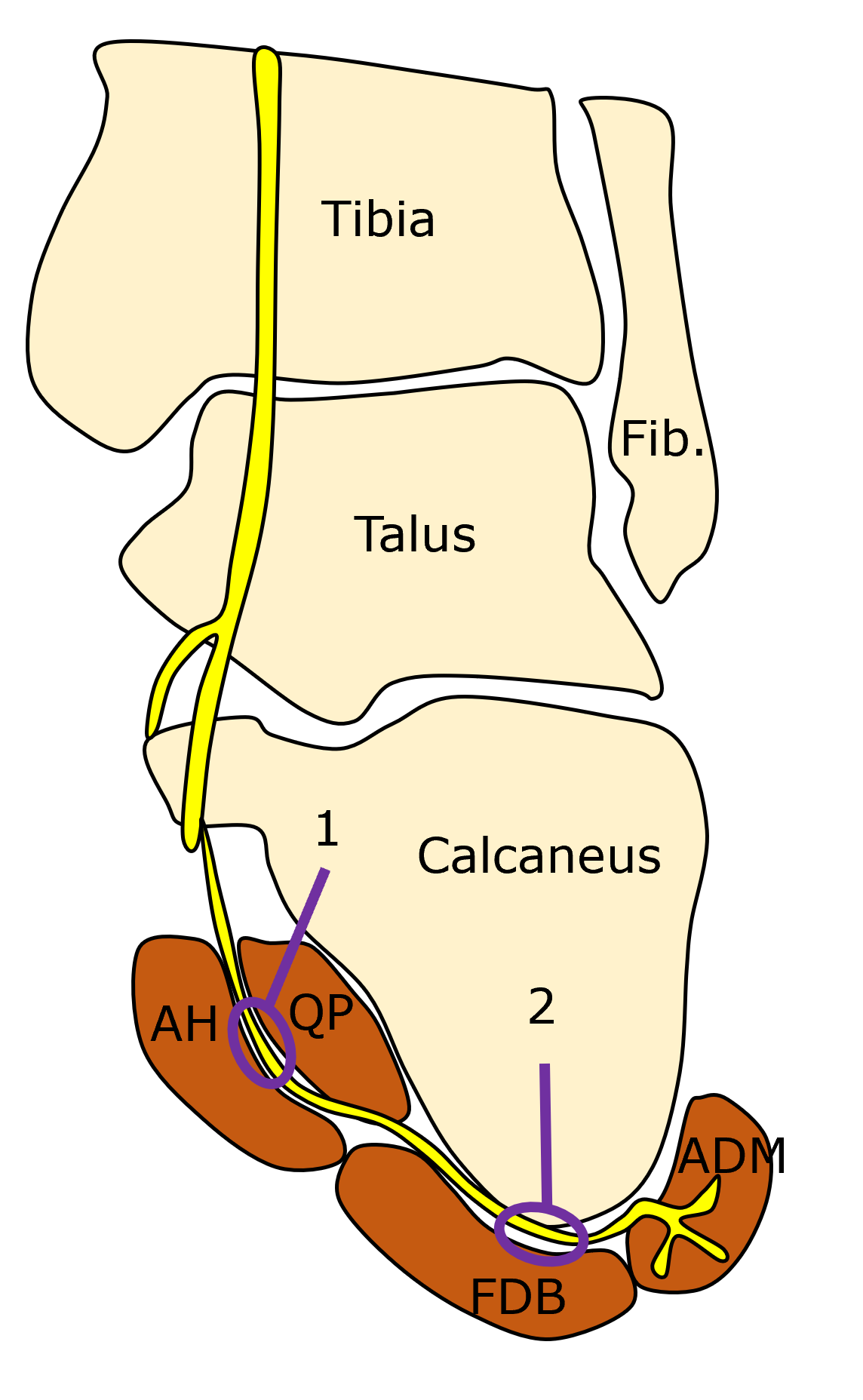Baxter's Nerve Entrapment
Baxter's nerve entrapment, also known as Baxter neuropathy, is plantar heel pain arising from compression of the inferior calcaneal nerve (Baxter nerve).
Anatomy

The inferior calcaneal nerve (Baxter nerve) is the first branch of the lateral plantar nerve, which is itself a branch of the tibial nerve. The nerve lies in between the abductor hallucis muscle and quadratus plantae.
The Gray's anatomy image and many other anatomy textbook images are incorrect. The Baxter nerve is quite posterior and lies very close to the calcaneus. It was named after Donald Baxter.[1]
Pathophysiology
There are three entrapment points:[2]
- Where the nerve runs between the deep fascia of the abductor hallucis and medial plantar margin of the quadratus plantae
- More distally along the anterior aspect of the medial calcaneal tuberosity. A calcaneal plantar enthesophyte and/or soft tissue changes of plantar fasciitis may contribute to entrapment at this second location.
Aetiology
The following are some causes of entrapment[3]
- Repetitive microtrauma. E.g. those with jobs requiring prolonged standing or walking, or avid runners. Plantar fasciitis. Fat pad atrophy.
- Acute trauma. direct trauma from a fall or stepping on a hard object, scar tissue after plantar fasciotomy.
- Impingement from bony exostosis, calcaneal spur, neuroma, neurilemmoma
- Stretch injury from a hypermobile pronating foot, abductor hallucis hypertrophy in runners
- Diabetic peripheral neuropathy.
Epidemiology
It is estimated that up to 20% of patients with chronic heel pain may be due to Baxter nerve entrapment.[1]
Risk Factors
Obesity, age, diabetes, muscle hypertrophy, hyperpronated foot, pes planus, plantar calcaneal spur, plantar fasciitis, spondyloarthritis.
Clinical Features

The clinical features may be similar to or coexist with plantar fasciitis. However there may be less morning pain, occasional altered sensation, and intrinsic muscle atrophy. The pain is felt in the medial heel and is often burning. It may worsen with prolonged standing and walking. It typically has a gradual onset.
There are two groups of patients with this condition: keen runners and those involved in everyday living.[1]
On examination the patient may walk with exaggerated supination to avoid placing weight on the medial heel. They are tender over the medial calcaneal tubercle similar to the location for plantar fasciitis.
Differential Diagnosis
- Plantar Fasciitis
- Fat Pad Contusion
- Calcaneal fractures (traumatic and stress)
- Inferior Calcaneal (Baxter) Nerve Entrapment
- Medial Calcaneal Nerve Entrapment
- Lateral Plantar Nerve Entrapment
- Medial Plantar Nerve Entrapment
- Tarsal Tunnel Syndrome
- Lumbar Radicular Pain
- Talar stress fracture
- Retrocalcaneal bursitis
- Spondyloarthritis
- Osteoid osteoma
- CRPS
Differentiation from plantar fasciitis is not always straight forward. MRI can be helpful.
If the patient has back pain then consider L5 or S1 radicular pain and examine for radiculopathy (See Lumbar Radicular Pain).
If the patient has bilateral heel pain then consider a rheumatologic origin.
Investigations

On MRI in the acute phase there is decreased T1 signal intensity and increased T2 signal intensity with fat saturation in the muscles innervated by the Baxter nerve. In the chronic phase there is fatty change of the abductor digiti minimi muscle, and occasionally the Flexor Digitorum Brevis and Quadratus Plantae.
Ultrasound can show a thickened and hypoechoic plantar fascia. This doesn't rule out Baxter nerve entrapment because a thickened plantar fascia can entrap the nerve.
Treatment
The nerve can be injected with corticosteroid and/or hydrodissected under ultrasound guidance.
External Links
Baxter's Nerve (First Branch of the Lateral Plantar Nerve) Impingement - Radsource
References
- ↑ 1.0 1.1 1.2 1.3 Baxter, D. E.; Thigpen, C. M. (1984-07). "Heel pain--operative results". Foot & Ankle. 5 (1): 16–25. doi:10.1177/107110078400500103. ISSN 0198-0211. PMID 6479759. Check date values in:
|date=(help) - ↑ Moroni, Simone; Zwierzina, Marit; Starke, Vasco; Moriggl, Bernhard; Montesi, Ferruccio; Konschake, Marko (2019-01). "Clinical-anatomic mapping of the tarsal tunnel with regard to Baxter's neuropathy in recalcitrant heel pain syndrome: part I". Surgical and radiologic anatomy: SRA. 41 (1): 29–41. doi:10.1007/s00276-018-2124-z. ISSN 1279-8517. PMC 6514163. PMID 30368565. no-break space character in
|title=at position 123 (help); Check date values in:|date=(help) - ↑ 3.0 3.1 A.M. Trescot (ed.), Peripheral Nerve Entrapments: Clinical Diagnosis and Management, DOI 10.1007/978-3-319-27482-9_76
- ↑ Bauones, S., Feger, J. Baxter neuropathy. Reference article, Radiopaedia.org. (accessed on 15 Apr 2022) https://doi.org/10.53347/rID-25994
- ↑ Baxter's nerve Sd. Procedure: corticosteroid injection & orthotics. Good result. @Dr_Ramon_Balius #MSKUltrasound pic.twitter.com/ED9RcmqJnz
Literature Review
- Reviews from the last 7 years: review articles, free review articles, systematic reviews, meta-analyses, NCBI Bookshelf
- Articles from all years: PubMed search, Google Scholar search.
- TRIP Database: clinical publications about evidence-based medicine.
- Other Wikis: Radiopaedia, Wikipedia Search, Wikipedia I Feel Lucky, Orthobullets,



